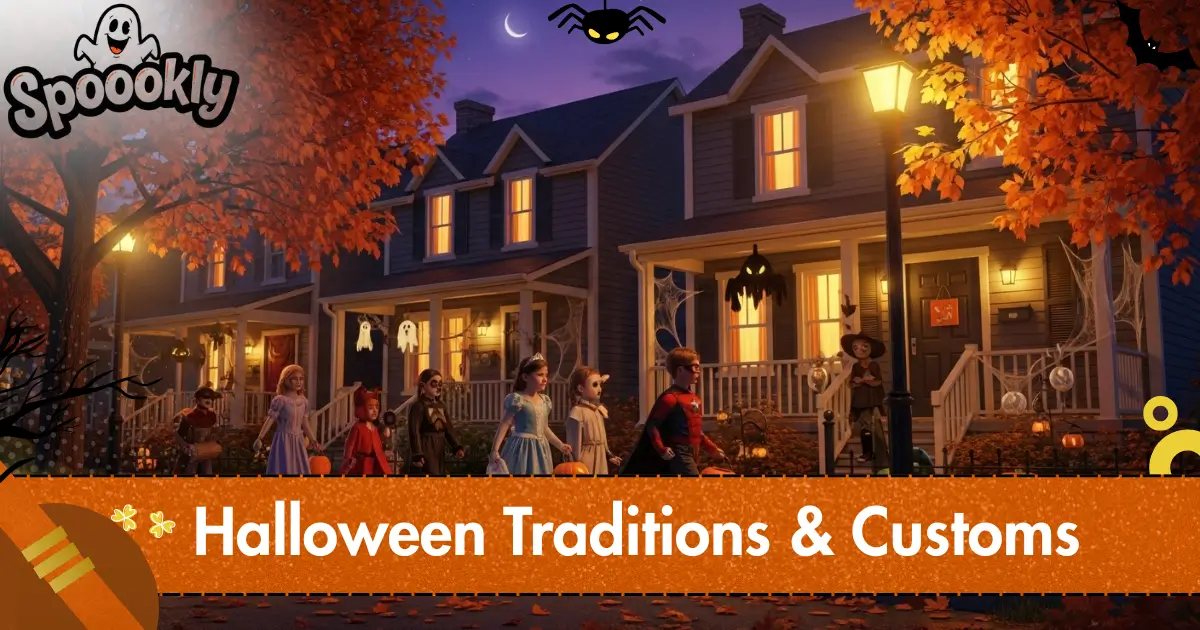Every October 31, children dress as goblins, adults carve pumpkins, and neighborhoods light up with spooky charm. But where did all this begin?
Halloween traditions are more than just fun, they’re a blend of ancient rituals, spiritual beliefs, cultural customs, and modern celebrations that have evolved over centuries.
From the Celtic harvest festival of Samhain to today’s family-friendly events, Halloween connects past and present. Whether you’re in it for the candy or the history, these customs captivate all ages with a powerful mix of fear, fun, and folklore.
Ancient Roots: Samhain and the Celtic Origins of Halloween
Halloween’s story begins over 2,000 years ago with the ancient Celtic festival of Samhain (pronounced SOW-in), celebrated in what is now Ireland, the UK, and northern France.
Samhain marked the end of the harvest season and the beginning of the dark, cold winter. The Celts believed that on the night of October 31, the boundary between the worlds of the living and the dead grew thin.
That meant spirits could return to Earth, some to visit, others to cause trouble. This idea of a “thinning veil” is one of Halloween’s deepest spiritual origins.
Key terms to remember:
- Samhain = Summer’s end
- Celtic Festival = Harvest and spiritual transition
- Pagan Rituals = Honoring nature, the dead, and seasonal change
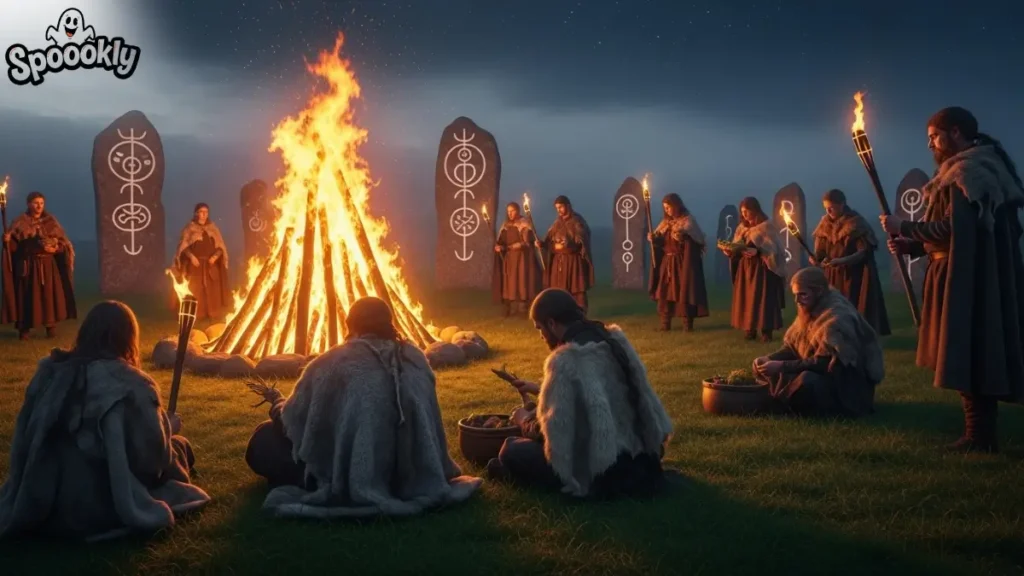
Do you want to play games on this Halloween? Then try these Adult Halloween Party Games.
Fires, Costumes, and Ghostly Disguises
To protect themselves from wandering spirits, the Celts lit massive bonfires in sacred spaces. These fires weren’t just about warmth, they were spiritual shields.
People would gather around these fires to perform rituals, offer sacrifices, and wear animal skins or costumes. The disguises helped to confuse spirits or scare them away. This tradition is the earliest known use of costumes in Halloween history.
Over time, these masks and outfits transformed from spiritual protection into symbols of fun and fear. Today, Halloween masks, costumes, and themed attire all trace their roots to this pagan custom.
| Ancient Custom | Modern Equivalent |
|---|---|
| Bonfires | Jack-o’-lanterns, fire pits |
| Animal Disguises | Halloween costumes |
| Spirit protection | Haunted house themes |
From Samhain to All Hallows’ Eve
By the 8th century, Christianity spread across Celtic lands, bringing changes to the spiritual calendar.
In an effort to replace or merge pagan customs, Pope Gregory III declared November 1 as All Saints’ Day, a day to honor all saints and martyrs.
The night before, October 31, became known as All Hallows’ Eve. Over time, that name evolved phonetically into Halloween.
Though the name changed, the traditions persisted. People continued to hold vigils, dress up, and even light fires, now in the name of saints rather than spirits.
What changed?
- Samhain = Pagan spiritual festival
- All Saints’ Day = Christian holy day
- Halloween = Blended tradition with a new name
Souling, Guising, and the Birth of Trick-or-Treat
In medieval England, the practice of “souling” emerged. Poor people, especially children, would go door-to-door on All Hallows’ Eve asking for “soul cakes”. In return, they offered prayers for the dead.
This tradition slowly transformed. In Scotland and Ireland, it evolved into “guising,” where children performed songs or told jokes in exchange for treats or coins.
When these customs crossed the Atlantic with Irish and Scottish immigrants, they morphed again. By the early 20th century, the American version trick-or-treating was born. Instead of prayers or performances, children simply asked, “Trick or treat?”
Timeline:
| Era | Tradition | Region |
|---|---|---|
| 10th century | Souling | England |
| 16th century | Guising | Scotland/Ireland |
| 20th century | Trick-or-treating | USA/Canada |

Also play these Best Family Games on this Halloween!
Jack‑O’‑Lanterns: From Turnips to Pumpkins
One of the most recognizable symbols of Halloween is the Jack-o’-lantern. But it didn’t start with pumpkins.
The original version came from an old Irish folktale about a man named Stingy Jack, who tricked the devil and was cursed to wander the earth. Jack carved out a turnip, placed a glowing coal inside, and used it as a lantern.
In Ireland and Scotland, people carved turnips or potatoes into scary faces and placed them in windows to ward off evil spirits.
When Irish immigrants came to America, they found that pumpkins, native to North America were larger and easier to carve. Thus, the pumpkin became the face of Halloween.
Quick Facts:
- Turnips were used before pumpkins.
- Stingy Jack’s tale inspired the name “Jack-o’-lantern”.
- Pumpkins became popular due to size and availability.
Jack-o’-Lantern Evolution
| Item Carved | Region | Time Period |
|---|---|---|
| Turnips | Ireland/Scotland | Pre-19th century |
| Pumpkins | USA | 19th century+ |
Games and Fortune-Telling: Apples and Barmbrack
Halloween wasn’t always about costumes and candy. In many cultures, it was also a time for divination and fortune-telling.
One of the most loved games, even today, is apple bobbing. In old Celtic and British customs, apples were believed to bring romantic luck. The first person to bite an apple in the water bowl was thought to be the next to marry.
Another Halloween food with hidden meaning is Barmbrack, a traditional Irish fruitcake. It was baked with hidden tokens like a coin, a ring, or a cloth. Each item represented a different fortune:
- Ring = You’ll marry soon
- Coin = Prosperity
- Cloth = Hard times ahead
These customs added excitement and supernatural flair to Halloween celebrations.
Do you go to school? Then try these Halloween Classroom Games.
Halloween Fortune Symbols
| Item in Barmbrack | Meaning |
|---|---|
| Ring | Marriage |
| Coin | Wealth |
| Cloth | Misfortune |
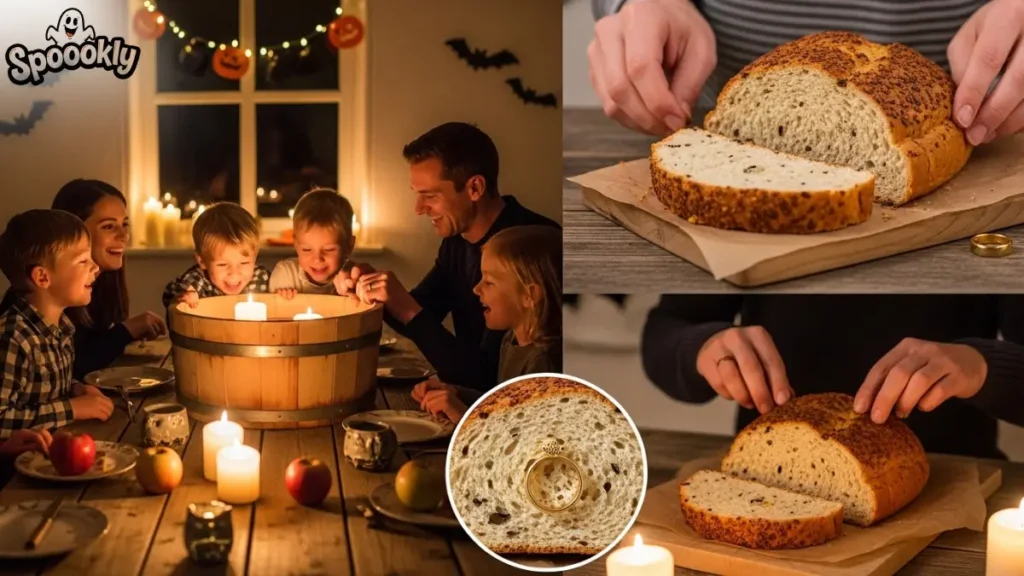
Mischief Night and Beggars’ Night: Tricks Before Treats
Before Halloween became the candy fest it is today, Mischief Night was the main event in some regions.
Celebrated on October 30, this tradition included minor pranks like soaping windows, toilet papering trees, or switching porch furniture. It was sometimes called “Devil’s Night”, especially in places like Detroit, where it became infamous for serious vandalism during the late 20th century.
To combat this, some communities created Beggars’ Night, especially in cities like Des Moines and Columbus. Here, kids would trick-or-treat on October 30 instead of the 31st. This was meant to reduce bad behavior by encouraging supervised, organized fun.
Regional Variation:
| Tradition | Date | Region |
|---|---|---|
| Mischief Night | Oct 30 | Northeast US, UK |
| Devil’s Night | Oct 30 | Detroit |
| Beggars’ Night | Oct 30 | Midwest US (Iowa, OH) |
Halloween in America: From Folk Customs to Pop Culture
When Irish and Scottish immigrants arrived in America during the 19th century, they brought their Halloween customs with them.
At first, it was a modest celebration. But by the 1920s and 1930s, American towns began organizing trick-or-treating events to keep kids out of trouble. The aim was to stop vandalism by giving them something more fun to do like dressing up and collecting candy.
By the 1950s, Halloween became a booming industry. Candy companies, costume makers, and media outlets jumped in. TV shows began airing Halloween specials, and schools hosted costume parties. The spooky season transformed into a fun, family-friendly occasion celebrated coast to coast.
Halloween in the USA: Key Shifts
- Pre-1900s: Immigrant traditions, limited reach
- 1920s–30s: Community-led events to reduce mischief
- 1950s onward: Mass commercialization, family parties
Highlights of Commercial Halloween Today:
- Billions spent on candy and costumes
- Haunted houses draw millions of visitors
- Halloween-themed TV, music, and merchandise
What Are Halloween Colors? Read this Halloween colors article.
Halloween Customs Across Cultures
While many people associate Halloween with American traditions, its celebration spans the globe. Various countries embrace their own Halloween-inspired customs, blending folklore, history, and seasonal rituals.
Europe: Folklore, Games, and Spooky Lights
In parts of the UK and Ireland, traditions remain close to Halloween’s ancient roots. Turnips were carved long before pumpkins became the standard in North America. In Somerset, England, there’s a festival called Punkie Night, where children parade with lanterns made from root vegetables.
Old-fashioned games like apple bobbing and nut roasting also remain popular in parts of Britain and Scotland. These weren’t just party games, they were often used for fortune-telling, especially regarding love and marriage.
Latin America: Día de Muertos Meets Halloween
In Mexico and other Latin American countries, Halloween customs often overlap with Día de Muertos (Day of the Dead). While Halloween is about costumes and fun, Día de Muertos is a heartfelt remembrance of ancestors.
Children take part in calaverita, a practice similar to trick-or-treating, where they go house to house asking for small gifts or sweets while carrying decorated skulls.
This blend of cultures adds depth to Halloween season across the Americas.
Ireland: Barmbrack and Symbolic Bread
Ireland, where Halloween’s origins began, still observes the season with traditions like barmbrack, a type of fruit bread baked with tokens inside. Each item predicts something about the eater’s future, such as love, wealth, or loneliness.
While some traditions have faded, others, like storytelling, ghost walks, and haunted castle tours, remain central to Irish Halloween culture.
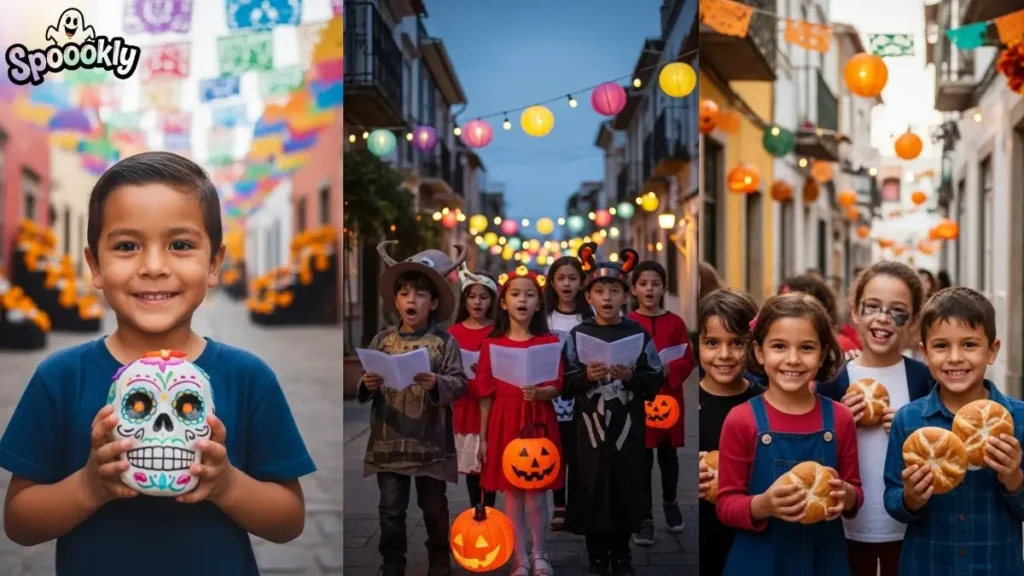
Global and Modern Variations of Halloween
While Halloween is rooted in Celtic and Christian traditions, it has taken on many forms across the globe.
In Mexico, the Day of the Dead (Día de los Muertos) is a vibrant, multi-day event that honors ancestors. Children take part in “calaverita”, a tradition similar to trick-or-treating, where they ask for sweets while holding decorated skulls or baskets.
In the Philippines, children and adults celebrate Pangangaluwa, going house to house in costumes, singing songs for the souls of the dead.
Portugal has a similar custom called Pão-por-Deus, where children receive small bread rolls, fruit, or candy in exchange for prayers. These are all cultural cousins of Halloween that reflect shared values—remembrance, celebration, and community giving.
Global Halloween-Like Celebrations
| Country | Local Tradition | Key Feature |
|---|---|---|
| Mexico | Calaverita | Kids ask for candy with skulls |
| Philippines | Pangangaluwa | Singing for the dead in costume |
| Portugal | Pão-por-Deus | Bread given for prayers |
These global variations keep Halloween meaningful and culturally rich while adding flavor to the seasonal festivities.
Explore these amazing Halloween Potluck Food Ideas.
Creative Halloween Traditions for Today’s Celebrants
Modern Halloween continues to evolve. While costumes and candy are still key, many families and communities are creating new traditions that are fun, safe, and inclusive.
Here are some popular modern additions:
1. DIY Lantern-Making:
Instead of just carving pumpkins, families are crafting lanterns from jars, gourds, or paper. These lanterns can line walkways or serve as indoor decor.
2. Family-Friendly Games:
Classic activities like costume contests, haunted scavenger hunts, or pumpkin bowling bring kids and adults together for low-cost, high-energy fun.
3. Themed Halloween Recipes:
Parents and party hosts are preparing fun, spooky treats like “mummy hot dogs,” ghost cupcakes, and spider-shaped cookies. These add a creative (and tasty) twist to Halloween night.
4. Safe Trick-or-Treating Options:
In many communities, trunk-or-treat events have become popular. These involve decorated car trunks in school or church parking lots, offering a safe and controlled space for kids to collect candy.
Creative Traditions for All Ages
- Host a neighborhood pumpkin display
- Organize a Halloween movie night outdoors
- Create a family costume theme (e.g., pirates or classic monsters)
- Bake Barmbrack or candy apples at home
These additions help modern Halloween keep its charm while meeting today’s needs for safety, creativity, and togetherness.
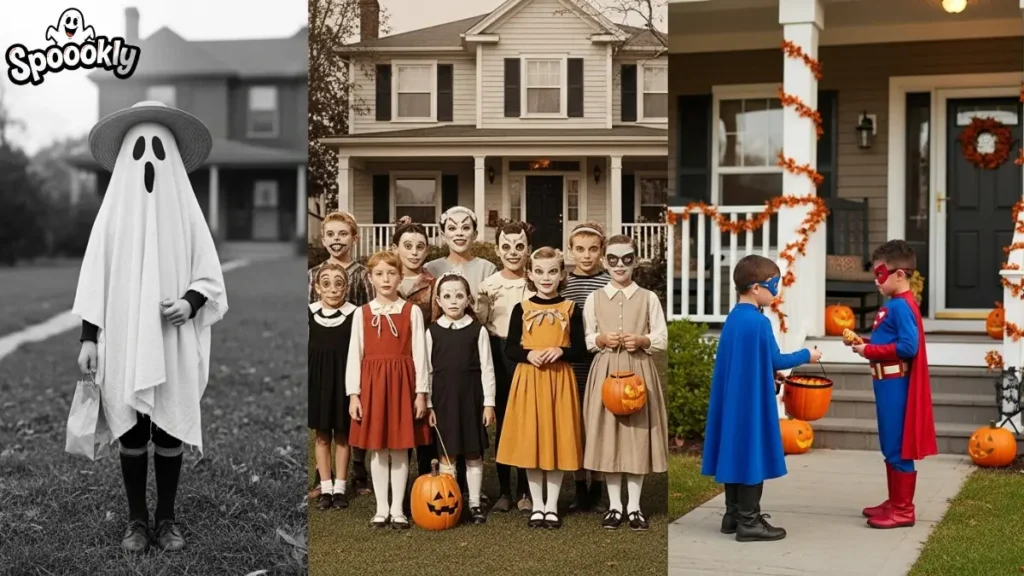
Why Halloween Still Matters Today
Halloween is more than just spooky fun. It connects people to ancient rituals, seasonal transitions, and shared stories. It brings neighbors together, encourages imagination, and helps both kids and adults express themselves.
For many, it’s a moment to honor the past, celebrate the present, and imagine magical possibilities for the future. Whether you’re carving a pumpkin or telling a ghost story, you’re part of something bigger—a tradition that’s survived wars, religions, migrations, and modern trends.
At its core, Halloween is about community, creativity, and connection.
From Bonfires to Candy Bowls
Halloween has traveled a long road from the sacred fires of Samhain to the candy-filled sidewalks of suburbia.
Its traditions, old and new, carry layers of meaning. Every carved pumpkin, every costume, every bite of candy is tied to centuries of storytelling, spiritual belief, and social connection.
We’ve seen how:
- Samhain honored the seasonal change and spiritual veil.
- Bonfires and disguises protected against spirits.
- All Hallows’ Eve merged Christian and pagan elements.
- Souling and guising became trick-or-treating.
- Stingy Jack gave us the Jack-o’-lantern.
- Fortune-telling games brought mystery and fun.
- Global customs shaped a rich, worldwide tradition.
- Modern celebrations adapt to today’s families and communities.
These aren’t just spooky stories, they’re reminders of how cultures evolve and celebrate together, year after year.
Why It Still Matters: Culture, Connection, and Creativity
I believe Halloween isn’t just a holiday. It’s an annual invitation to be part of something larger.
It reminds us to pause and connect—with nature’s seasons, with those who came before us, and with each other. Whether you enjoy the history, the costumes, or the candy, you’re participating in a global, time-tested tradition.
For families, it’s a memory-making day. For communities, it’s a reason to gather. And for the curious, it’s a doorway into ancient beliefs and evolving customs.
FAQs
Halloween began as Samhain, a Celtic festival marking the end of harvest and the start of winter. It later blended with Christian celebrations like All Saints’ Day.
It evolved from souling (prayers for the dead in exchange for food) and guising (performances for treats), brought to America by Irish and Scottish immigrants.
The tradition began in Ireland with turnips, based on the legend of Stingy Jack. Pumpkins became popular in the U.S. due to size and availability.
Apple bobbing and Barmbrack fortune-telling were popular ways to predict love, luck, and future events.
Yes, versions of Halloween exist globally, Mexico’s Day of the Dead, Portugal’s Pão-por-Deus, and the Philippines’ Pangangaluwa are a few examples.
Try hosting a costume-making night, bake traditional foods like Barmbrack, organize a community pumpkin walk, or start a lantern-lighting tradition with your family.

